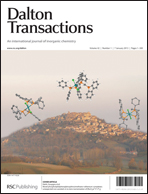Reactions of either Pd(0) phosphine complexes with dipyridyldichalcogenides or [PdCl2(P∩P)] (P∩P = dppe, dppp) with pyridylchalcogenolate ions have been examined and a variety of Pd(II) complexes have been isolated and characterized. Oxidative addition of {SeC5H3(3-R)N}2 (R = H or Me) to [Pd(P∩P)2] (P∩P = dppe, dppp) gave either a mononuclear complex, [Pd{2-Se-C5H3(3-R)N}2(P∩P)] (for P∩P/R: dppe/H or Me; dppp/H) or a cationic binuclear complex, [Pd2{μ-SeC5H3(3-Me)N}2(dppp)2]2+ (4b) (R = Me) whereas reactions involving the tellurium analogue exclusively afforded trinuclear complexes, [Pd3(μ-Te)2(P∩P)3]Cl2 (P∩P = dppe (2) or dppp (6)). The latter was also obtained in the substitution reaction between [PdCl2(P∩P)] and NaTeC5H3(3-R)N. The substitution reactions between [PdCl2(dppe)] and Pb{EC5H3(3-R)N}2 yielded mononuclear complexes, [Pd{2-E-C5H3(3-R)N}2(dppe)] (1a–1e) (E = S, Se or Te) while in the case of [PdCl2(dppp)], the reactions resulted in the formation of mono-, bi- and tri- nuclear complexes depending on the nature of the chalcogen atom (E = S, Se or Te) and the substituent on the pyridyl ring (R = H or Me). Treatment of dipyridyl ditellurides, {TeC5H3(3-R)N}2 (R = H or Me), with [Pd(PPh3)4] gave expected tellurolate complexes, [Pd{2-TeC5H3(3-R)N}2(PPh3)2] (7a, 7b) which on prolonged standing in CDCl3 solution gave green crystals of [PdCl{2-Te(Cl)2C5H3(3-Me)N}(PPh3)] (9). The molecular structures of {TeC5H3(3-Me)N}2, [Pd2{μ-TeC5H3(3-Me)N}2(dppp)2]Cl2·3H2O (5·3H2O), [Pd3(μ-Te)2(dppp)3]Cl2·3CHCl3 (6·3CHCl3) and [PdCl{2-Te(Cl)2C5H3(3-Me)N}(PPh3)] (9) were established by single crystal X-ray diffraction analyses.


 Please wait while we load your content...
Please wait while we load your content...